Wellness Activities at Work: 30 Ideas to Boost Performance and Wellbeing
Last Updated Sep 17, 2025

Employees are stressed—and they’re not hiding it.
Nearly 75% of American workers worry about their wellbeing at work, yet less than 25% believe their employer genuinely cares. Burnout is rampant. Mental health leaves are skyrocketing—up 33% just 2023, and 300% over the past six. For CHROs, these trends can’t be ignored.
Fortunately, there’s a light at the end of the tunnel: employees who do feel cared for are three times more engaged and 69% less likely to jump ship. That’s a huge advantage in today’s competitive market.
But superficial perks won’t get you there. And a 2024 study showed that many popular wellness offerings—like standalone apps or one-off classes—had little to no effect. Some even made things worse by coming off as out of touch.
The difference-maker? Intentional, culture-embedded wellness that supports the whole person—not just on paper.
Uncover the benefits of real, research-backed wellness strategies that move the needle on engagement, retention, and productivity.

What You’ll Learn
- Why Wellness Matters: The latest research on how employee wellbeing drives engagement, productivity, and retention – and the costly risks of ignoring it.
- Workplace Wellness Activities Defined: What “wellness activities at work” really encompass (hint: it’s more than just step challenges or free fruit in the breakroom).
- 30 Wellness Activity Ideas: A curated list of 30 effective wellness initiatives – with detailed examples – in six categories: Physical, Mental & Emotional, Social, Nutritional, Financial, and Flexibility/Policy.
- Real ROI Data: Compelling stats from Wellhub, Gallup, McKinsey, SHRM, and more showing the ROI of wellness programs (e.g. impact on healthcare costs, absenteeism, etc.).
- HR’s Top 6 FAQs – Answered: Honest, practical answers to common questions like “How do we measure success?”, “What if employees don’t participate?”, and “How can we support remote staff?”.
- Actionable Takeaways: How to tie it all together – linking employee wellness to company performance – and a clear next step to kickstart your organization’s wellness journey.
What Are Workplace Wellness Activities?
Workplace wellness activities are programs, initiatives, or daily practices that support employees’ health and wellbeing.
These can be physical (e.g. on-site fitness classes), mental/emotional (stress management workshops, meditation breaks), social (team volunteering days), nutritional (healthy office snacks, nutrition coaching), financial (401k education, personal finance seminars), or related to flexibility and policy (remote work options, mental health days). In short, these activities go beyond standard health benefits – they’re proactive efforts to help employees feel and perform their best.
A holistic wellness program might include a mix of offerings that target different dimensions of wellbeing, recognizing that an employee’s health is multi-faceted. The goal is to create a work environment where healthy choices are easy and wellbeing is part of the culture, not an afterthought.
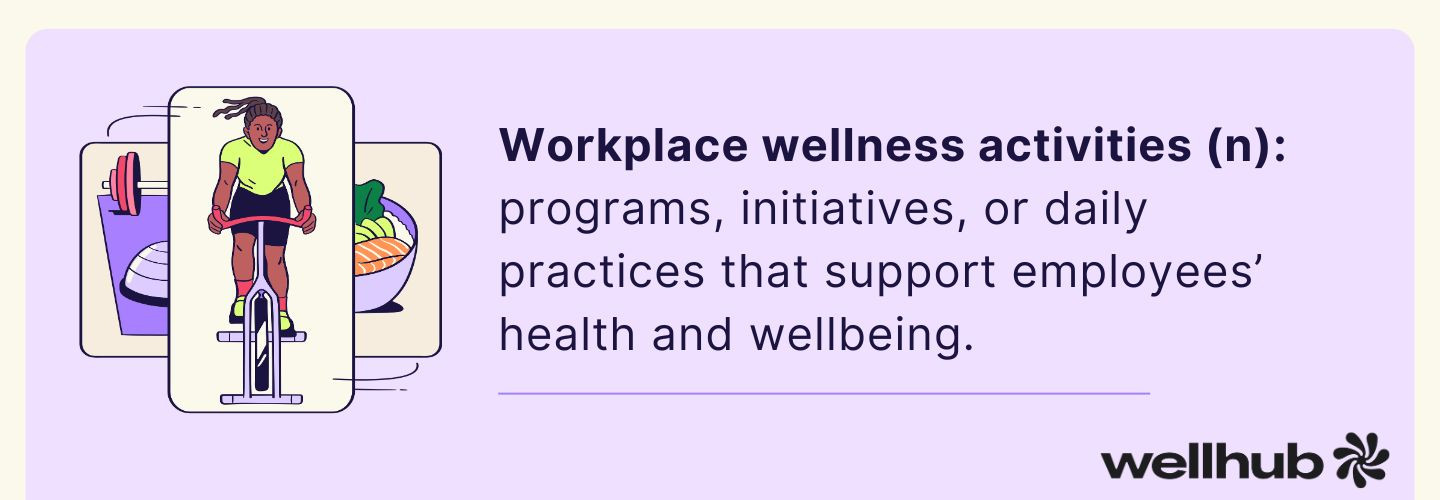
Get inspired with 57 workplace wellness initiative ideas.
The Business Case for Wellness: Latest U.S. Stats and Trends
Let’s briefly look at why investing in wellness activities is mission-critical for HR leaders today. The data paints a clear picture of both the challenges and opportunities:
- Employee Wellbeing Is Faltering: Global surveys show that only 33% of employees feel they are thriving in their overall lives. In the U.S., Gallup found that just about 22% of employees strongly agree their organization cares about their wellbeing – near a record low. This means roughly four out of five employees don’t feel supported, a disconnect that has grown since the pandemic’s peak when nearly half felt cared for.
- Burnout & Mental Health Issues Are Surging: According to a recent SHRM/ComPsych analysis, mental health-related leaves of absence jumped 33% in 2023 compared to 2022, continuing a years-long trend (up 300% since 2017). Over 57% of employees report at least moderate burnout levels. Employers are aware that this is an issue they need to tackle: in a 2023 Mercer survey, 68% of employers cited job stress as a top concern and 67% said the same for anxiety and depression. The bottom line is that many employees are struggling – and it’s affecting attendance, performance, and morale.
- Wellness = Engagement & Retention: The flip side is also true – when wellness is prioritized, employees notice. In a Wellhub study, 79% of employees with wellness perks said HR genuinely cares about their wellbeing, versus only 45% of those at companies without wellness programs. And importantly, workers with wellness benefits are far more likely to be happy with their company (61% vs 36%). Happier employees stick around: Gallup found those who feel cared for are 69% less likely to actively job hunt.
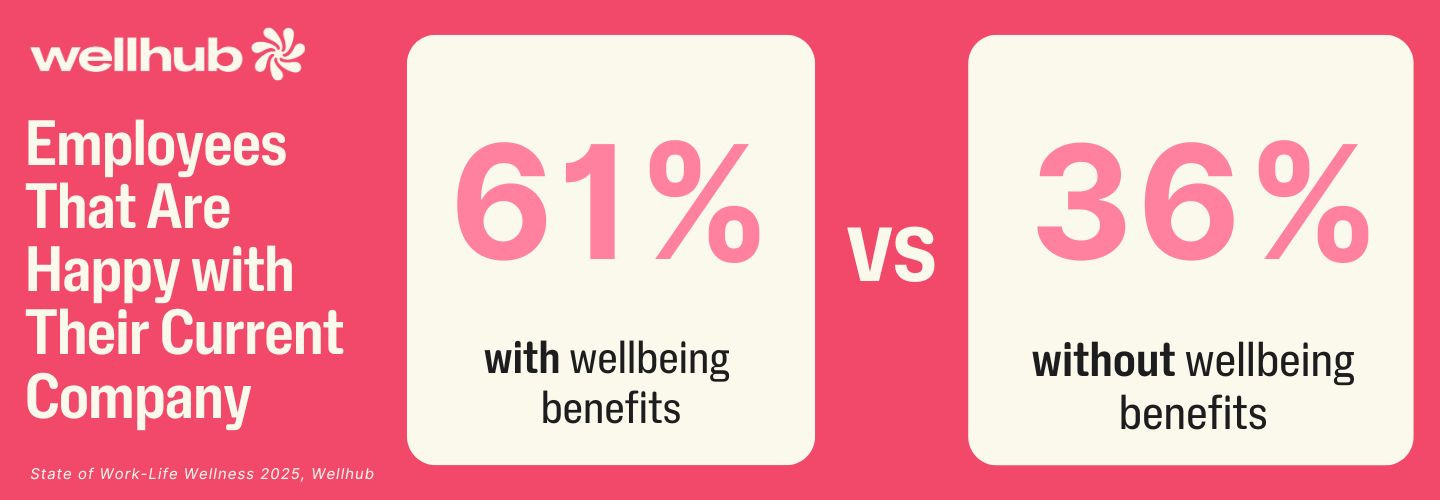
- ROI and Executive Buy-In: Far from being a cost center, well-designed wellness initiatives tend to pay for themselves (and then some). Industry surveys have historically found returns of $1.50 to $3 per $1 spent on wellness over time in healthcare savings and productivity gains. In 2025, the McKinsey Health Institute projected that improving employee health and wellbeing globally could unlock $3.7–$11.7 trillion in economic value due to higher productivity and reduced healthcare burdens. It’s no surprise that 68% of CEOs credit wellness programs for cutting healthcare costs for their companies. Top executives are prioritizing wellness more than ever as a strategic lever for performance.
- Health & Financial Impacts: Neglecting wellness has real costs. For example, untreated physical and mental health issues drive absenteeism and lost productivity. In the U.S., cardiovascular disease alone costs employers $156 billion in lost productivity annually, and employees with untreated insomnia cost roughly $2,300 more per year in healthcare and productivity losses. On the flip side, healthier employees can significantly boost performance – one analysis linked a one-point increase in employee wellness/happiness to a $1.4 to 2.3 billion increase in annual profits on average. No wonder 67% of CEOs say their wellness programs reduce absenteeism and 80% say they help attract talent in today’s competitive labor market.
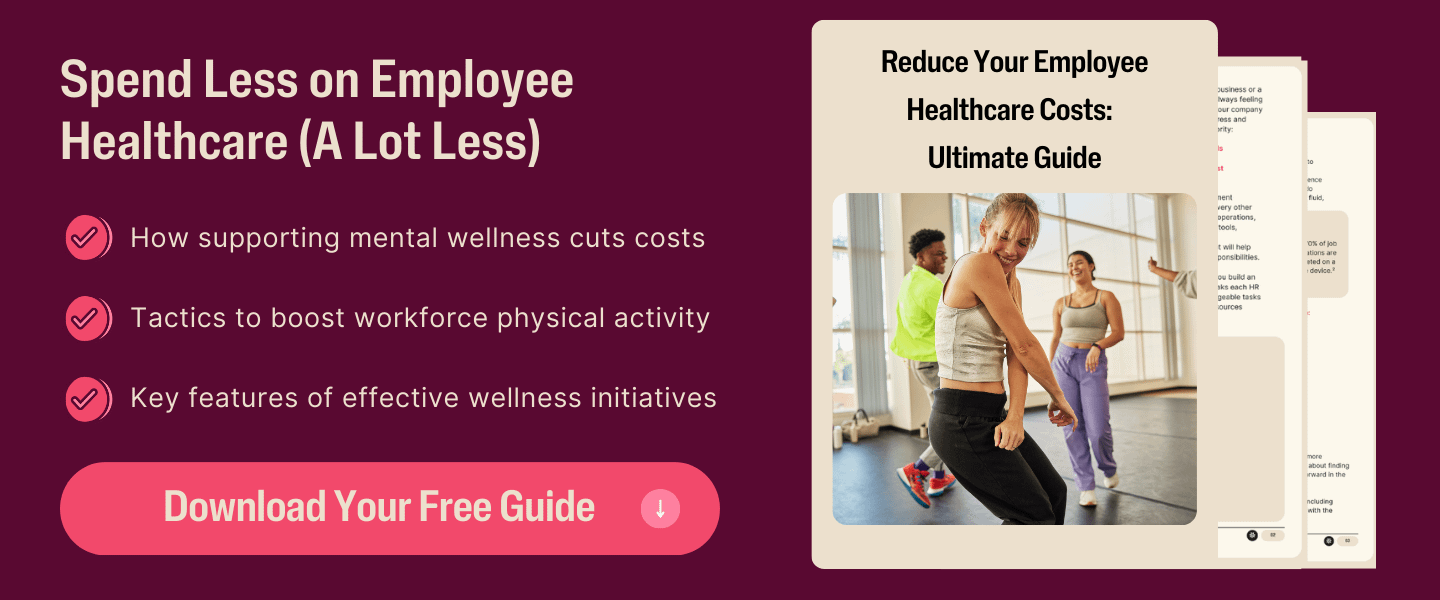
In short, employee wellness is a must-have for organizations that want to thrive. Leaders who ignore these trends do so at their own risk: disengaged, burned-out employees directly undermine customer satisfaction and company performance.
On the other hand, by proactively addressing wellness, companies can reap benefits like lower turnover, higher engagement, lower healthcare costs, and a stronger employer brand.
The simple big picture to keep in mind is supporting your people’s wellbeing is not just about kindness – it’s about smart business.
Dive deep into how workplace wellness can make your organization more successful.
30 Wellness Activities at Work (Across 6 Key Categories)
Now let’s get practical. These ideas range from small daily habits to company-wide programs. Each is chosen for its proven benefits and feasibility – many of them cost little to implement but can make a big difference in how employees feel day-to-day.
Whether you’re a seasoned HR leader or just starting to build a wellness program, consider mixing and matching activities from all categories for a holistic approach. (And remember, Wellhub can help streamline many of these efforts through its all-in-one wellness platform – more on that later.)
Physical Wellness Activities (Fitness & Movement)
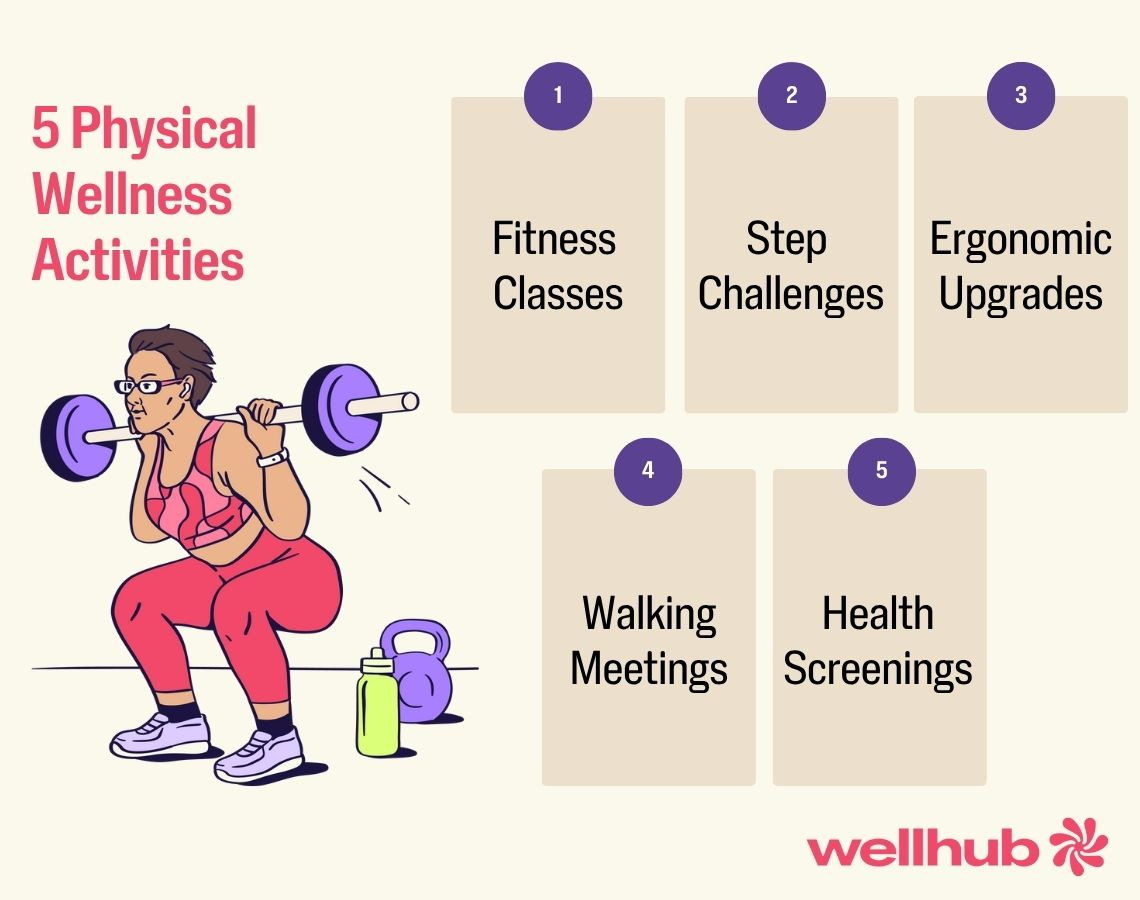
Supporting physical health on the job can boost energy, reduce sick days, and improve mood. Here are a few ideas:
- On-site or Virtual Fitness Classes: Offer group workouts that employees can join during lunch or after work (yoga, Pilates, Zumba, HIIT, etc.). This could be in a spare conference room or via Zoom for remote teams. Tip: Rotate class types to cater to different interests and fitness levels. Attendance tends to spike when there’s variety and when leaders join in to set an example.
- “Steps” Challenges or Active Breaks: Encourage movement with friendly competitions – e.g. a month-long step count challenge (trackable via fitness apps) with prizes, or a daily 10-minute “stretch and stroll” break for everyone. Short activity breaks can combat the sedentary nature of desk jobs. According to the CDC, even a 5-minute move break each hour significantly improves circulation and focus.
- Ergonomic Workstations: Invest in ergonomics to prevent fatigue and injuries – think standing desks, ergonomic chairs, screen glare protectors, etc . — and make day of deployment, teaching employees how to set up their workspace posture correctly. Some companies bring in ergonomics specialists for quick desk assessments or offer stipends for home office gear (for remote staff). Healthy posture and less back pain = happier, more productive employees.
- Walking Meetings: Make some meetings mobile. If the weather and topic permit, encourage managers to conduct one-on-one meetings while walking outside (or pacing indoors if needed). This injects physical activity into routines and can spark creativity. It’s a simple cultural tweak that shows leadership cares about movement. (Bonus: sunlight and fresh air can boost vitamin D and mood.)
- On-site Health Screenings or Fitness Assessments: Partner with healthcare providers to offer free annual health check-ups, flu shot clinics, or fitness assessments at the office. Bringing preventive services in-house makes it easier for employees to know their numbers (blood pressure, cholesterol, etc.) and take action. It’s a popular wellness perk and demonstrates a commitment to employees’ physical health.
Love these? Keep going with 5 more fitness challenge ideasand 17 plug-and-play physical wellness ideas.
Mental & Emotional Wellness Activities
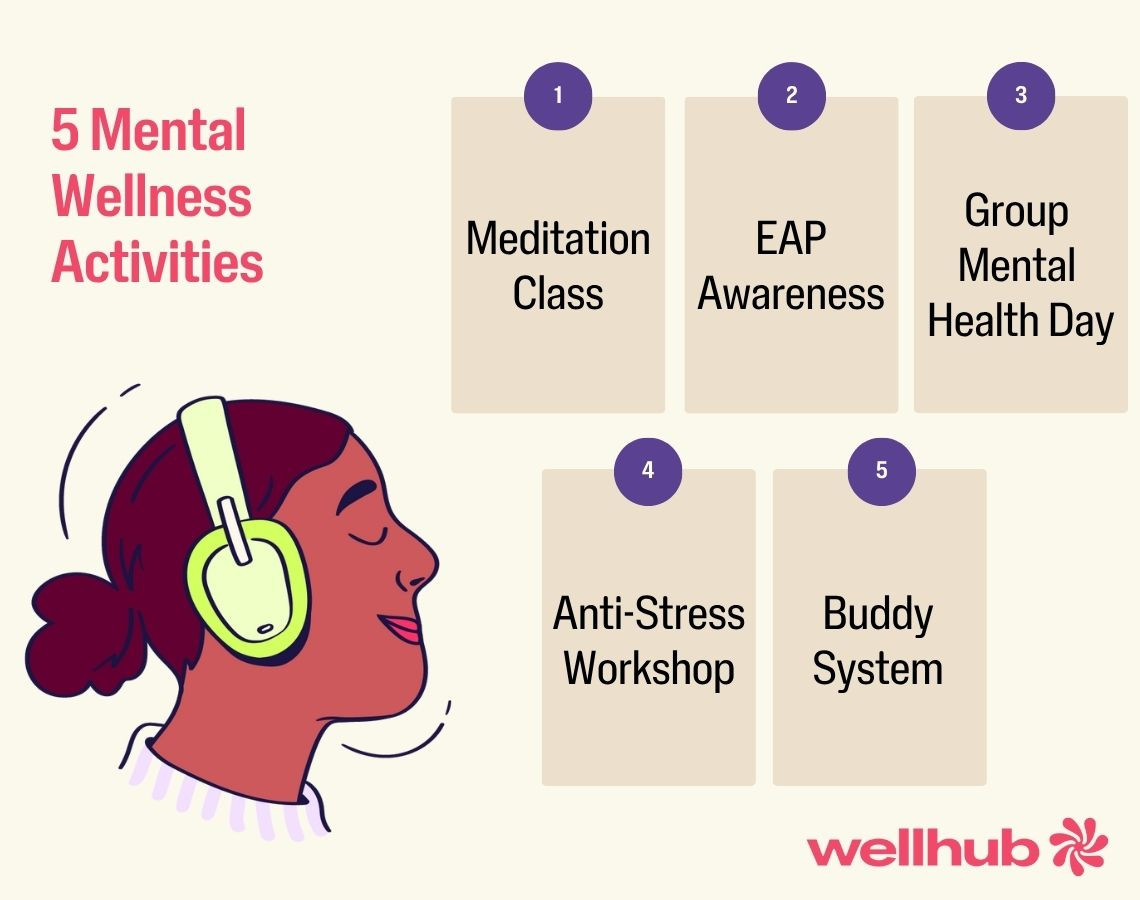
Mental health is the workplace topic of the moment – and for good reason. Stress, anxiety, and burnout are rampant, but supportive employers can make a real difference. Consider initiatives like:
- Mindfulness & Meditation Sessions: Offer guided meditation or mindfulness breaks, either live (led by an instructor or a mindful employee volunteer) or via apps. Even just 10 minutes of deep breathing and quiet can reduce stress. Some companies start weekly all-hands meetings with a 2-minute breathing exercise. It might feel novel at first, but normalizing these practices can chip away at stigma and help employees build resilience. (Pro tip: Wellhub’s program includes access to top mindfulness apps and content.)
- Employee Assistance Program (EAP) Promotion & Enhancement: Ensure your EAP (which typically provides free counseling sessions, mental health resources, etc.) is well publicized and easy to use. Shockingly, 31% of employees don’t even know if their company has an EAP, and among those who do, 81% have never used it. HR can destigmatize EAP use by regularly reminding staff of what’s available, perhaps sharing anonymized success stories (“Last year, 50 of your colleagues used our counseling benefit – it’s there for you too”). If you don’t have an EAP, consider adding one, or look into expanding mental health coverage in your insurance plan (e.g. more therapy sessions).
- Company-Wide Mental Health Days Encourage employees to actually use their PTO – especially for mental wellbeing. Some companies have introduced designated “mental health days” (separate from vacation) or company-wide break days where the whole office shuts down for a collective breather. Example: After a grueling product launch or busy season, declare a “Wellness Friday” off for all. This not only helps recovery, but sends a powerful message that leadership values mental health.
- Stress-Reduction Workshops: Host interactive talks on topics like stress management, building resilience, or coping with anxiety. Bring in a psychologist or use virtual webinars. Be sure to keep it practical – e.g. teaching breathing techniques, time management tips to reduce overwhelm, or how to recognize signs of burnout. Done right, these workshops give employees tools to navigate challenges. (Just avoid a lecture-y tone; make it engaging and acknowledge that stress is normal and okay to talk about.)
- “Buddy System” or Peer Support Groups: Create safe spaces for employees to support each other. This could be as informal as a Slack channel about mental wellbeing where people share tips and encouragement, or more formal like peer support circles that meet monthly. Some organizations train employee volunteers as mental health first aiders – points of contact if someone is struggling and needs to be guided to resources. Knowing that “you’re not alone” at work can dramatically improve emotional wellbeing.
Remember: Building a culture that supports mental health can drastically improve outcomes. For instance, in companies with comprehensive wellness programs, 75% of employees reported improved mental wellbeing over the last year, compared to just 43% at companies without such support. Even simple steps like those above can create a more empathetic, resilient workplace.
Strengthen workplace mental health:
- 7 proven strategies to strengthen emotional wellness at work
- Build psychological safety with these data-backed strategies
Social Wellness Activities (Community & Connection)
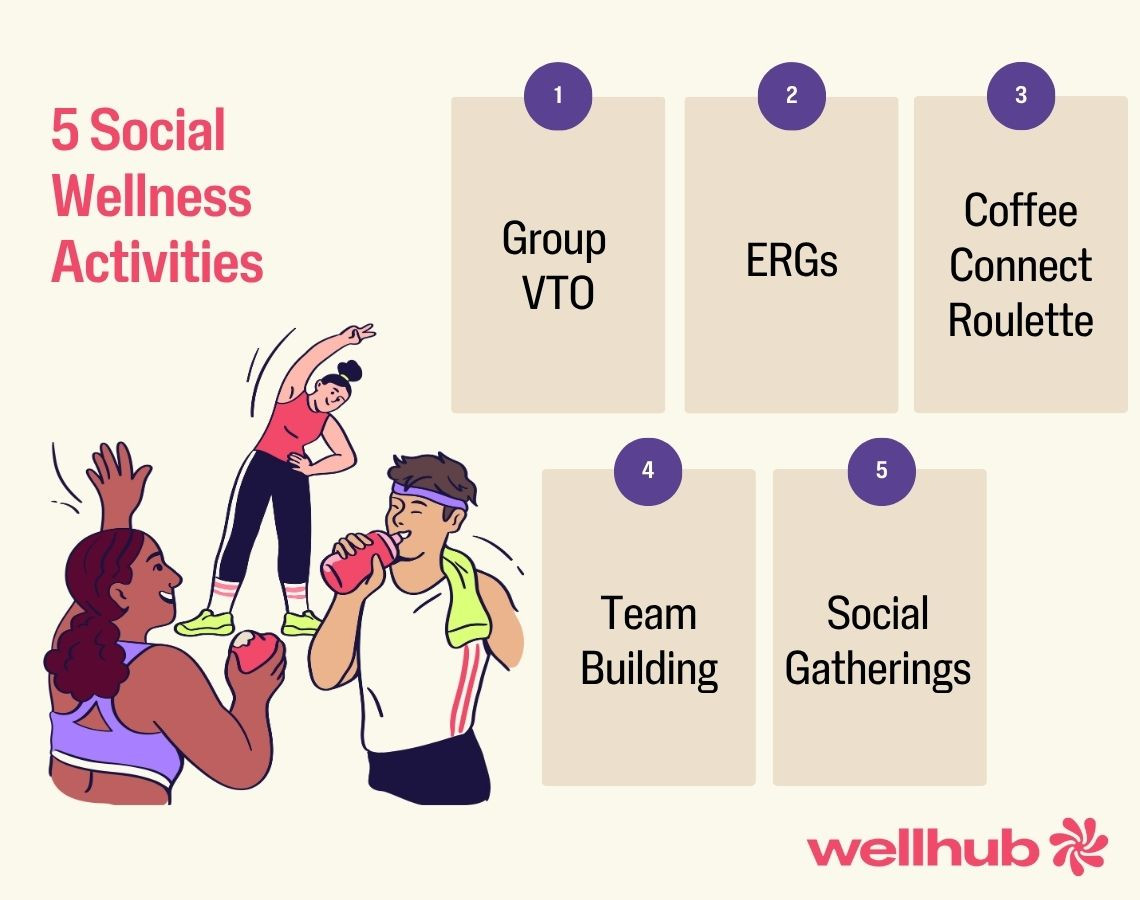
People do their best work when the office is a social place. Fostering positive relationships and a sense of belonging at work drives collaboration and retention—Gallup has identified “having a best friend at work” as a key engagement driver. Try activities that strengthen social bonds, such as:
- Team Volunteering Days: Organize volunteer opportunities for employees to participate in together. Whether it’s a day cleaning up a local park, building houses for Habitat for Humanity, or running a charity fundraiser, giving back as a group boosts social connection and purpose. Notably, research highlighted in the New York Times found that volunteering was the one wellness activity that consistently improved worker wellbeing in a broad study. It’s a win-win: employees feel good about helping the community and each other. Allow an annual paid volunteer day, or set up a company volunteer project each quarter.
- Employee Resource Groups & Clubs: Support employee-led social groups – whether based on shared interests (e.g. a running club, book club, board game group) or identity/affinity (e.g. a Women in Tech group, Parents group, LGBTQ+ network). Give these ERGs a small budget and work time to meet. They create a sense of community and support, especially in larger organizations. For instance, a lunchtime walking club or Friday cooking club can help people connect beyond work tasks.
- “Coffee Connect” Roulette: In hybrid or remote environments, it’s vital to encourage casual social interaction. One popular idea is a “coffee chat roulette” where employees are randomly paired (via an app or HR coordination) to have a 15-minute virtual coffee once a week with someone outside their usual team. This breaks down silos and helps newer employees meet others. Many HR leaders report that these small chats greatly enhance cross-team camaraderie and reduce feelings of isolation.
- Team-Building Wellness Games: Make wellness fun by gamifying it in groups. For example, host a company “step challenge” with teams competing rather than individuals, or a hydration challenge (which team can log the most water-drinking days), or even a healthy recipe cook-off where teams present dishes. The friendly competition and teamwork aspect will strengthen relationships. Just keep it light-hearted and optional – the goal is bonding, not pressure.
- Regular Social Gatherings (with a Wellbeing Twist): Don’t underestimate the power of simply bringing people together. Whether it’s a monthly catered healthy lunch, a “Wellness Wednesday” smoothie bar, or an off-site retreat focused on wellness activities, create occasions for employees to relax and socialize. For instance, some companies have instituted Friday “unwind” sessions – 30 minutes at week’s end where everyone can join a group stretch, share weekend plans, or celebrate wins. These rituals build a supportive culture where colleagues know each other as humans, not just emails – a key to social wellness at work.
Nutritional Wellness Activities
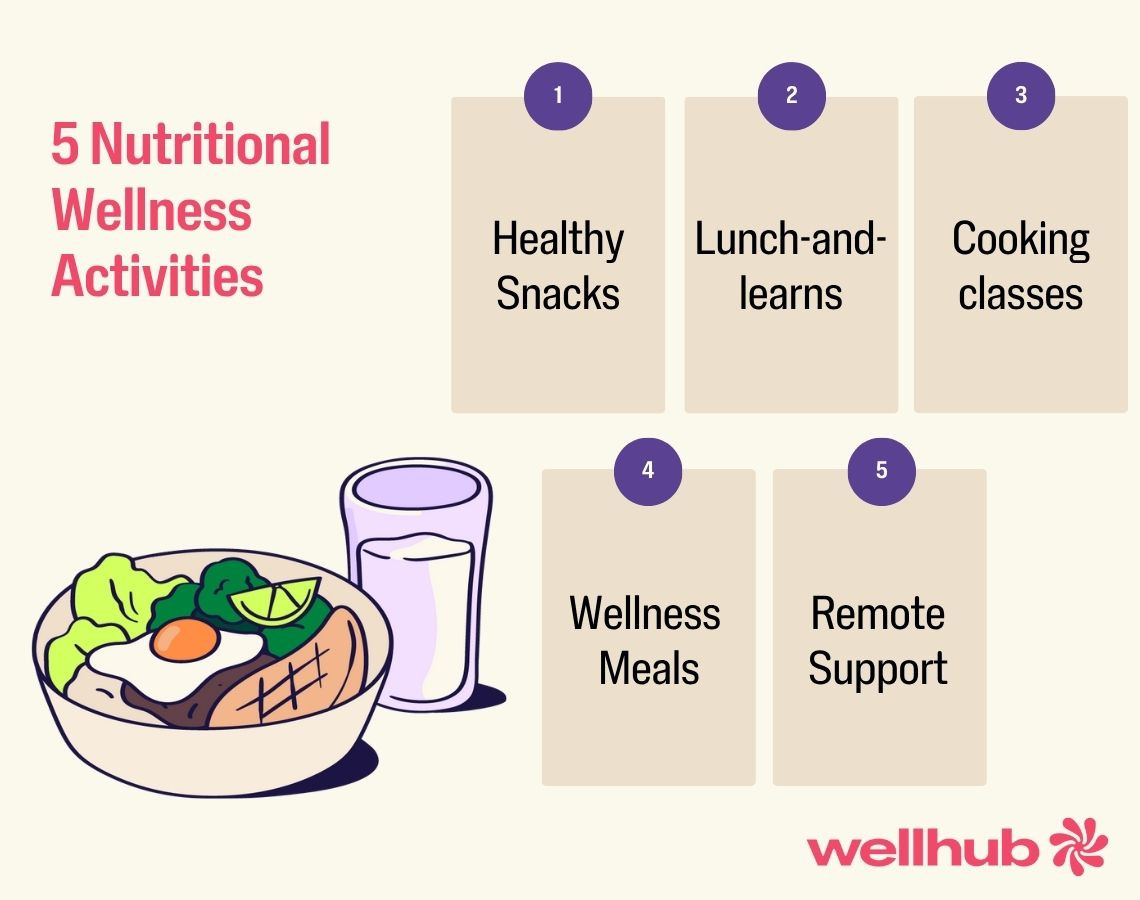
Nutrition often gets overlooked in wellness programs, yet it’s foundational to health and energy levels. Plus, food-related activities are highly engaging (who doesn’t love to eat?). Here are ways to nourish your team:
- Healthy Snacks & Office Nutrition: Stock the break room with healthier snack options – think nuts, fruits, yogurt, veggie chips – instead of just candy or vending machine junk. You can still have treats, but make the healthy choice the easy choice. Consider offering a monthly fresh fruit box or healthy snack subscription. Hydration is part of nutrition too: provide nice water dispensers, perhaps infused with citrus or berries, to encourage water over soda. These small changes in the office environment nudge better habits daily.
- Nutrition Lunch & Learns: Host seminars with a nutritionist or dietitian during lunch (virtual or in-person). Topics could include “Eating for Energy at Work,” “Meal Prepping 101,” or “Brain-Boosting Foods for Productivity.” Provide a healthy lunch for attendees to enjoy as they learn (e.g. salads, grain bowls). Employees appreciate practical, non-judgmental tips – like how to avoid the afternoon sugar crash, or quick nutritious breakfast ideas for busy mornings. If just one talk feels too short, consider a 4-week series or an online course that employees can opt into via your wellness platform.
- Cooking Challenges or Classes: Get people engaged with food in a hands-on way. You could organize a healthy recipe contest (employees submit recipes and everyone votes; winner gets a prize and bragging rights). Or bring in a chef (or partner with a local culinary school) for a live or video cooking class where employees learn to cook a simple healthy meal. This works great as a team-building event too – e.g. a virtual cook-along where the company sends everyone a meal kit. It’s both educational and a fun social activity.

- Catered “Wellness” Meals: If you cater meals for meetings or events, use those as opportunities to introduce healthier choices. For instance, during a lunch meeting, have a variety of salad bowls or a spread of Mediterranean food instead of the usual pizza. Highlight nutritious ingredients (“this quinoa bowl is rich in protein and fiber”). People often mimic what leaders eat, so if execs are piling on the veggies, others will follow! Over time this can subtly shift the culture around food.
- Guidance for Remote Workers: For those at home, nutrition can slip into an “eat at your desk” bag of chips habit. Share resources specifically for remote staff: perhaps a short ebook of healthy work-from-home snack ideas, or a Slack channel where people post pictures of their nutritious lunches to inspire each other. You might even sponsor a grocery delivery of healthy staples for interested remote employees (budget permitting). Showing you care about their nutrition at home reinforces that wellness isn’t just an office thing – it’s wherever employees are.
At the end of the day, Employees with wellness programs often report improved health behaviors. One survey noted 62% of participants said wellness offerings helped them lower healthcare costs, and more than half credited such programs for fewer sick days. Nutrition initiatives, combined with physical activity, play a big role in those outcomes.
Financial Wellness Activities
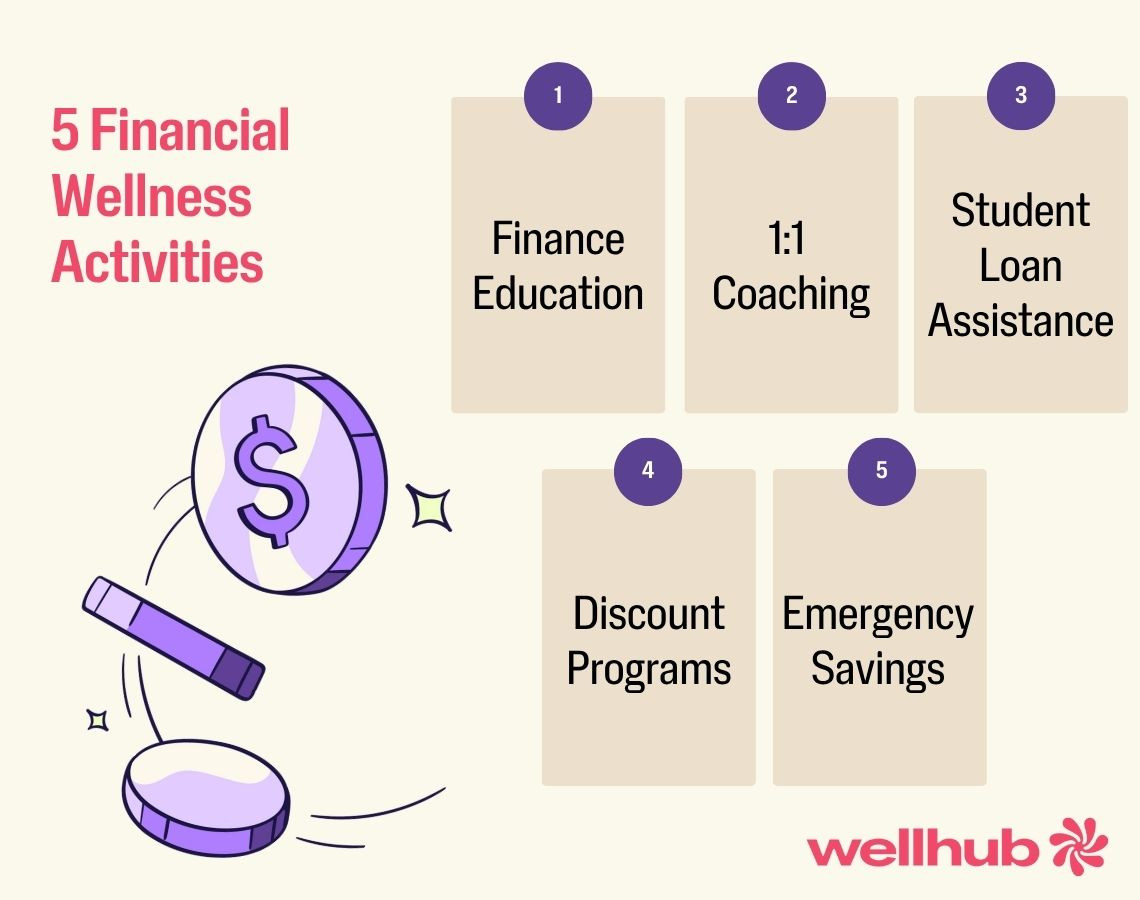
Financial stress is a silent killer of workplace productivity. In today’s economic climate, many employees are anxious about money – from daily expenses to retirement. In fact, 66% of people say their financial situation distracts them from work. Offering financial wellness support can help reduce stress and improve focus.
Here are some actionable plans you can take:
- Personal Finance Education: Organize workshops or webinars on key financial topics: budgeting, debt management, buying a home, saving for college, etc. You can bring in financial planners or partner with your company’s 401(k) provider for free sessions. Aim to cover the spectrum – for early-career folks, “Managing student loans and building credit” could be great, while for later-career, “Retirement planning catch-up” might resonate. Provide these on company time if possible (it shows you truly prioritize it). Financial literacy boosts confidence – an employee who learns how to consolidate their loans or finally build an emergency fund will have one less thing to worry about at work.
- One-on-One Financial Counseling: Consider offering access to free or subsidized sessions with a financial advisor or counselor as part of your benefits. Similar to an EAP but for money matters – employees could confidentially get advice on their financial situation. Even a couple of sessions per employee per year can help them make a solid plan. Another idea: offer an annual “financial wellness checkup” where an advisor helps them review their 401(k) choices, insurance, etc. Money stress often happens because people feel lost; guidance can alleviate that.
- Student Loan Assistance or Education Reimbursement: If budget allows, programs that help with education costs are hugely popular. This could range from a formal student loan repayment benefit (e.g. $100/month towards employees’ loans) to a more modest offering like negotiating a refinance discount with a provider, or simply hosting a “student loan best strategies” class. Likewise, tuition reimbursement for those pursuing further education shows you’re investing in their growth – and can improve retention. Financial wellness isn’t just about cutting costs; it’s also about enabling people to increase their earning potential through learning (which in turn benefits the company).
- Discount Programs and Perks: Help employees’ paychecks go further by providing access to discount marketplaces, negotiated deals, or other perks. Many employers partner with services that give discounts on everything from cell phone plans to gym memberships (Wellhub itself, for instance, offers an all-in-one subscription that can save employees money on fitness, mindfulness apps, nutrition programs, etc., versus buying each separately). Even highlighting free community resources (like free museum days or local coupon programs) in an internal newsletter can be a nice touch. Reducing out-of-pocket costs enhances financial wellbeing without raising salaries.
- Emergency Savings Initiatives: An increasingly popular benefit is helping employees build rainy-day savings. Some companies have set up programs where employees can divert a portion of each paycheck to an emergency savings account (sometimes with a small employer match or reward for participating). Others offer low-interest employee loans or hardship grants for those in a bind. By proactively encouraging a safety net, you reduce the chance that a financial curveball (car breakdown, medical bill) will send an employee into a stress spiral. It’s a compassionate move that also keeps employees more focused at work because they’re not panicking about finances.
Flexibility & Policy-Driven Wellness Activities
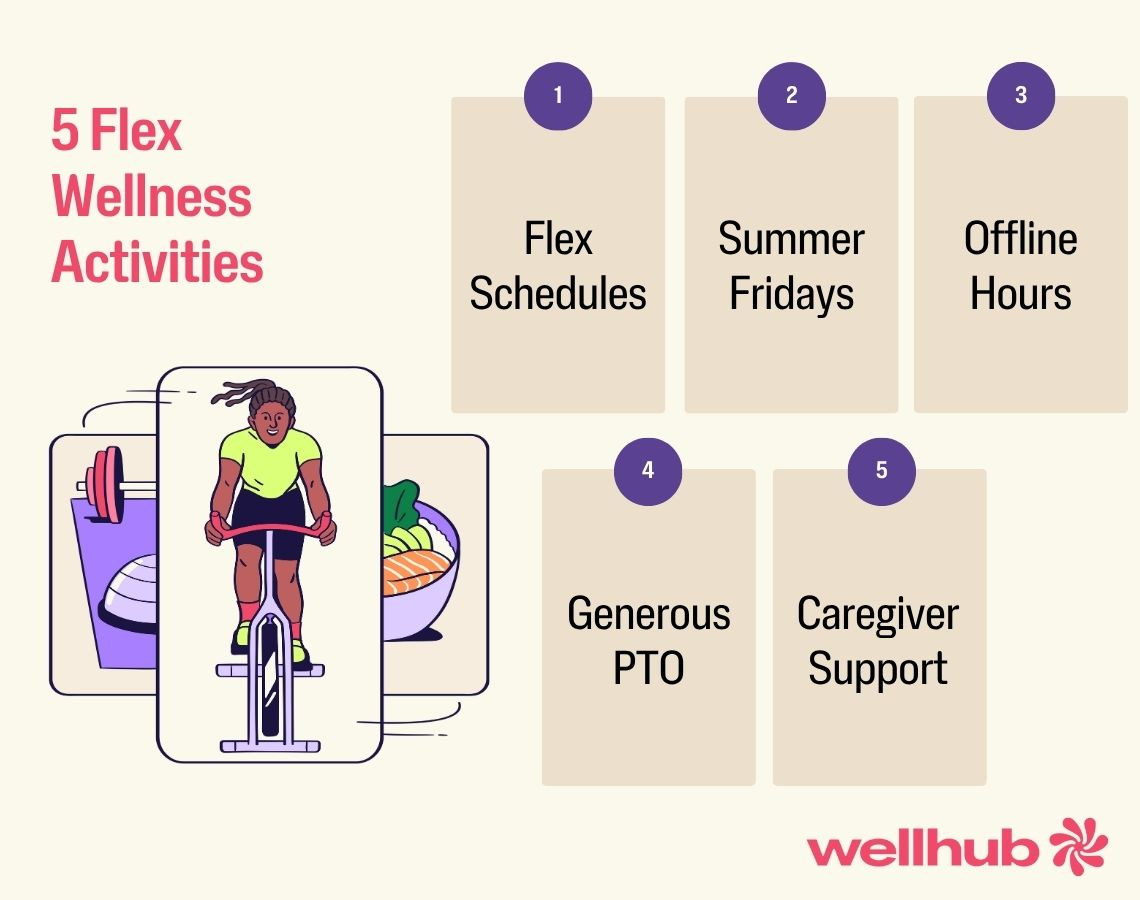
Wellness isn’t just about programs – it’s baked into your policies and how you design work. Arguably the biggest boosts to employee wellbeing come from giving people flexibility and reasonable work-life boundaries. Here are some policy-level moves:
- Flexible Work Schedules: Rethink the 9-to-5. Offering flexible hours or remote work options is a powerful way to improve wellbeing. Maybe parents can shift their hours earlier or later to accommodate school pick-ups, or anyone can work from home two days a week. Autonomy over one’s schedule reduces stress and allows employees to balance personal needs (like a mid-morning doctor visit or avoiding rush-hour traffic). Many companies saw productivity increase with flexible schedules during the pandemic, as employees gained hours back in their day. As long as the work gets done, who cares if it’s 7am or 7pm? Trust your team and give them some freedom – it’s essentially wellbeing on demand.
- Compressed Workweeks or “Summer Fridays”: Consider allowing a 4-day workweek (4x10 hours, for example) or half-day Fridays, at least during certain times of the year. Trials of four-day weeks have shown employees maintain output while experiencing less stress and more job satisfaction. Even if you can’t go full 4-day, offering a few extra Fridays off in the summer or around holidays (with no loss of PTO) can recharge people. The productivity lost is often negligible, and you gain immense goodwill. Just be sure to plan so that customer coverage isn’t impacted.
Keep top talent inspired with this professional growth blueprint. [20 ideas]
- Mandatory Disconnect Policies: Help employees truly unplug during off hours. This might mean setting guidelines like “No emails after 7pm or on weekends unless truly urgent” – and modeling that from the top. Some companies enforce “email free” hours or use tech tools that delay after-hours emails to the next morning. France even has a “right to disconnect” law! While that may not be feasible everywhere, encouraging managers not to expect 24/7 responses is crucial. When people have down time that’s actually down time, they come back to work far more refreshed and less likely to burn out.
- Generous PTO and Encouraging Its Use: It’s great to offer ample paid time off, but if the culture silently discourages taking it, employees won’t benefit. Ensure your PTO (and parental leave, etc.) policies are truly supportive. “Unlimited PTO” policies became trendy, but studies found employees often take less time off under them due to guilt. Whether you have limited or unlimited PTO, track usage – if you spot employees not taking much vacation, remind them (or even mandate a day off). Some firms have instituted a minimum vacation policy (e.g. everyone must take at least 10 days off a year). The key is to make time off normal and celebrated, not a sign of slacking. When people take breaks, they return re-energized, which boosts productivity in the long run.
- Enhanced Parental and Caregiver Support: A special note on flexibility for those with heavy caregiving responsibilities (new parents, those caring for aging relatives, etc.). Offering extended parental leave, gradual return-to-work options, childcare support, or flexible hours for caregivers can significantly reduce stress for these employees. They’re also policies that signal deep support for wellbeing. For example, some companies now offer paid caregiver leave (separate from PTO) for a week or two to care for a sick family member. These benefits foster immense loyalty – employees feel seen as whole people with lives outside work.
Each workplace is different, so the right mix of flexibility and wellness policies will vary. The guiding principle should be: empower employees to experience work-life wellness. Policies that grant a bit of breathing room and compassion go a long way to prevent burnout. As Gallup noted, employers should view work and wellbeing as interconnected – supporting employees’ life needs ultimately drives better work outcomes.
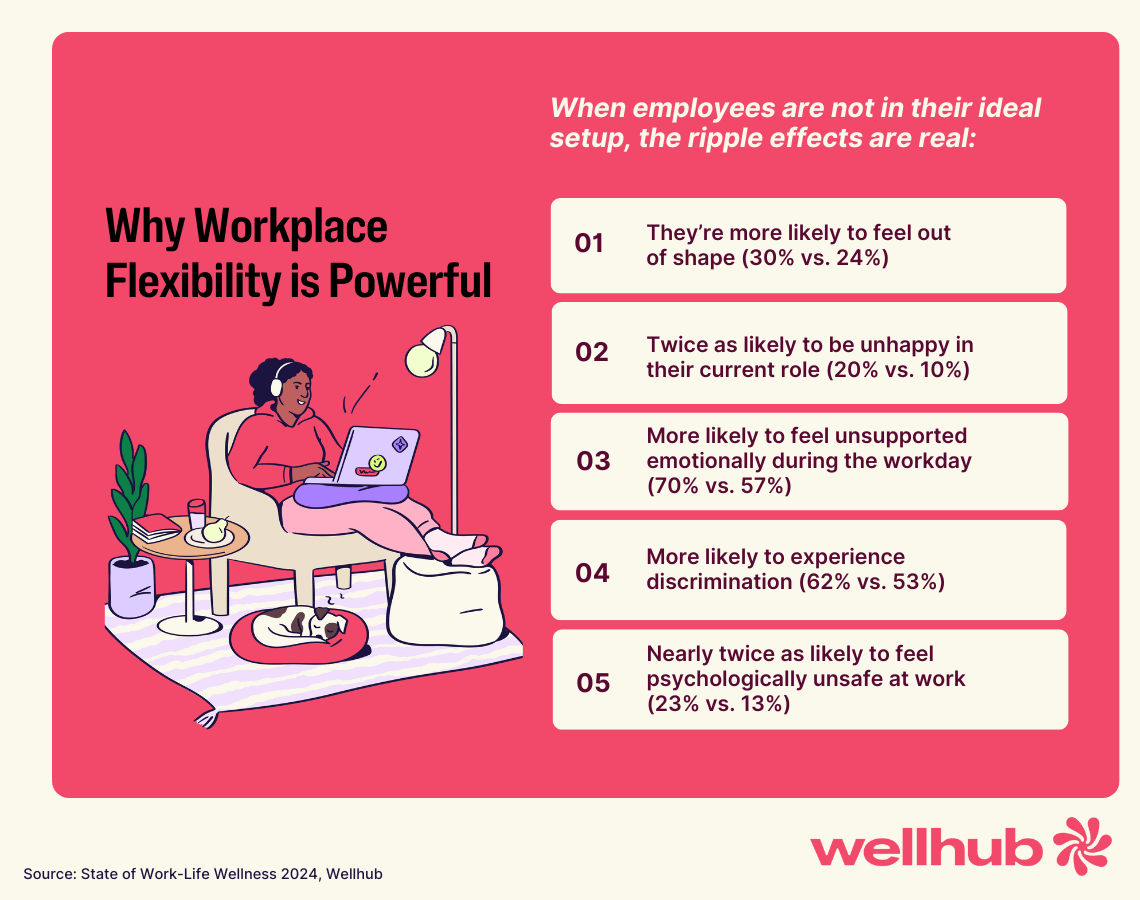
HR’s Top 6 Wellness FAQs (Answered)
Implementing wellness activities often raises some common questions from HR leaders and executives. It’s normal to encounter a bit of skepticism or concern – after all, we’re talking about changing culture and investing resources. Below we address six frequent FAQs from a strategic, evidence-based perspective, so you can confidently make the case for workplace wellness in your organization.
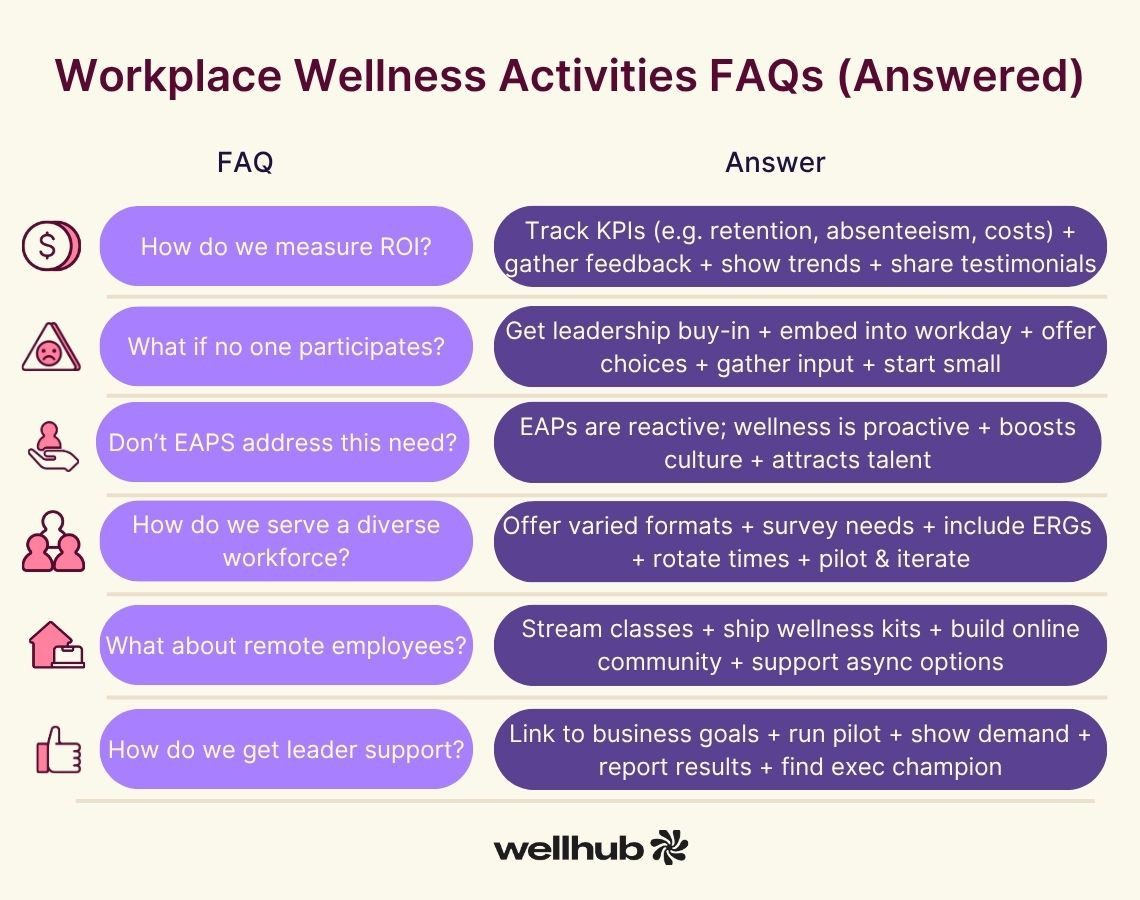
How do we measure the success or ROI of wellness programs?
Great question – showing results is key to sustaining support.
First, identify what metrics matter most to your organization’s goals. Common Key Performance Indicators (KPIs) for wellness include employee engagement scores, retention/turnover rates, absenteeism, healthcare cost trends, and even productivity measures. Many companies track before-and-after data once a wellness program is implemented. For example, did average sick days per employee drop? Did our insurance claims costs stabilize or decrease?
Also use employee feedback: pulse surveys can gauge changes in stress levels, morale, or how supported people feel. Gallup’s research offers some compelling benchmarks: in organizations where employees strongly feel their wellbeing is cared for, teams see higher productivity and profitability and lower turnover than those that don’t. You can likewise compare internal metrics between high-participation groups and low-participation groups. Over time, build an internal case study (e.g. “Since launching our wellness initiative, voluntary turnover decreased from 15% to 10%, saving an estimated $500K in hiring costs”).
ROI doesn’t have to be exact, but if you can show trends like improved retention or reduced absenteeism (which 67% of CEOs with wellness programs report seeing), that speaks volumes. And don’t forget qualitative ROI: employee testimonials about how the program helped them (e.g. “I’ve lost 10 lbs and feel more energetic at work thanks to our fitness classes”) can be powerful evidence to leadership that these efforts are making a difference in peoples’ lives – which ultimately feeds business success.
We made it easy: Launch your wellness program with this step-by-step guide.
What if employees don’t participate or seem too busy for these activities?
Low engagement is a common worry—in fact it’s the most common C-suite concern about wellness programs—but there are effective ways to foster a participation-friendly environment.
First, get leadership involved and visibly supportive. When managers and executives join the wellness activities (attend the workshops, take walking meetings, share their own wellness goals),research shows that employee participation also increases. Employees receive a clear message: “It’s okay to take time for this – in fact, it’s encouraged.” Make participation easy by integrating activities into the workday whenever possible (e.g. a 15-minute stretch break everyone does together at 3pm, or scheduling a meditation session right after a staff meeting).
Also, communicate the benefits that matter to employees: frame it not as “one more thing to do,” but as a stress-reliever or energy booster that will actually help them with their workload. Start with small, fun challenges or incentives to spark interest. For example, a simple step challenge with a prize can get people talking and joining in.
Gather feedback – maybe employees aren’t participating because the offerings don’t meet their needs. Survey them on what wellness activities they’d value most. It could be they prefer a different time or format.
Finally, address workload issues: if people are too swamped to take a 30-minute wellness break, that’s a signal to examine workloads or manager support. Sometimes managers fear losing productivity if employees are not at their desks. But remind them of the research: well-rested, less stressed employees work more efficiently. A 5-minute pause can pay back in higher focus. Share success stats from other companies or your pilot programs to build buy-in. Over time, as wellness becomes part of the culture (not an “extra”), participation will grow. Be patient but persistent – culture shifts take time, but once employees see colleagues benefiting (and having fun), they’ll be more inclined to jump in.
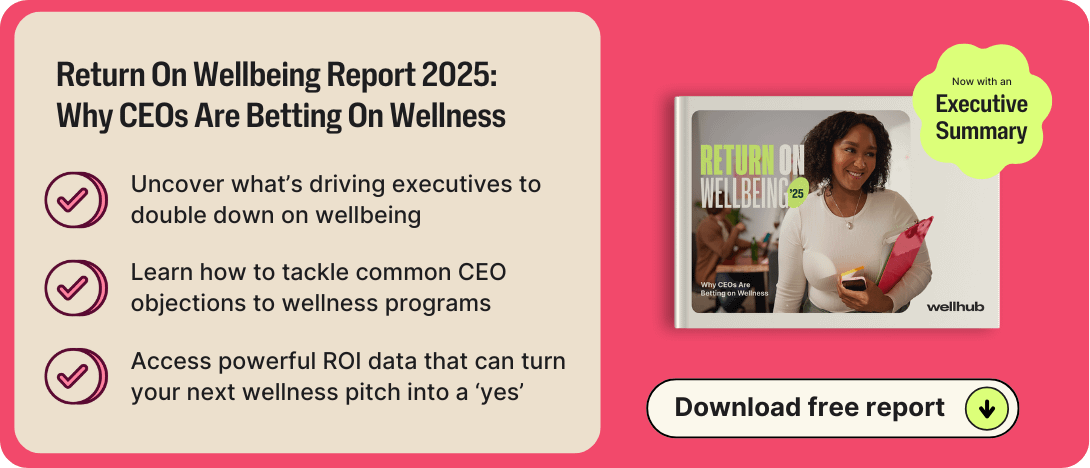
We already offer an EAP and basic benefits. Do we really need additional wellness programs?
An Employee Assistance Program and standard health insurance are important safety nets, but they often act as reactive solutions (helping once an issue has arisen). A comprehensive wellness program is more proactive and preventive. It fills the gaps by promoting healthy habits and addressing issues before they escalate. EAP usage, for instance, is typically very low (often <5% of employees use it). In fact, many employees are either unaware of EAP resources or don’t think to use them until crisis hits – as noted earlier, 31% don’t even know if they have an EAP.
By introducing engaging wellness activities (fitness classes, workshops, challenges, etc.), you normalize everyday wellbeing practices. These programs can catch people upstream – reducing the chances they’ll need more serious intervention.
Think of it this way: health insurance will pay for someone’s diabetes medication, but a wellness program might help that person improve their diet and exercise enough to prevent or manage diabetes in the first place. Similarly, an EAP provides counseling after someone is burned out, but a wellness program’s mental health initiatives might prevent severe burnout from happening or provide ongoing stress relief.
Additionally, wellness activities create community and culture around wellbeing in a way that passive benefits do not. An EAP is invisible until used; a group yoga class in the office is a visible sign that wellbeing is valued.
Lastly, in competitive talent markets, companies are increasingly going beyond basic benefits. Offering a robust wellness program can differentiate your employer brand – showing candidates and employees that you go the extra mile for their health and happiness. It’s something Millennials and Gen Z, in particular, look for in employers.
So, while EAP and insurance are essential, think of wellness programs as the glue that holds a healthy workplace together day-to-day. They make the idea of wellbeing tangible, fun, and part of the work routine, rather than a brochure in HR that might never get touched.
Get inspired with "The Ultimate Guide to Workplace Wellness Challenges for HR Leaders"
How can we tailor wellness initiatives to our diverse workforce (different ages, backgrounds, needs)?
One size does not fit all – and that’s okay. In fact, diversity can be a strength in designing a vibrant wellness program because you can offer a smorgasbord of options and let people choose what resonates.
Start by surveying or interviewing employees across demographics. What do your Gen Z employees crave? (Maybe social connection events or financial education on student loans.) What about your Gen X or Baby Boomers? (Perhaps flexibility for family caregiving or more ergonomic focus.) Consider the nature of different roles as well – your sales team might be traveling and need mobile wellness options, while your desk engineers might need on-site movement breaks. Use this input to ensure each category (physical, mental, etc.) has variety. For example, physical wellness could include both high-intensity fitness bootcamps and gentle walking groups. Mental wellness could offer both private meditation app subscriptions and group therapy sessions.
Cultural inclusivity is key too: be mindful of activities that might inadvertently exclude. If you host a “company softball game” as a wellness event, that’s great for athletic folks but maybe not for others – so balance it with non-competitive activities like a step challenge or yoga. Leverage Employee Resource Groups for ideas; they often know what their members might enjoy (e.g. a women’s network might spearhead a self-defense class for physical wellness and empowerment). Research shows certain groups experience poorer health outcomes – e.g. globally, younger workers and women have reported higher stress and worse holistic health. So targeting some initiatives for those groups, like mentoring for young employees or additional mental health support for women, can help close those gaps.
Also, consider scheduling and format: offer sessions at different times or recordings so both early birds and late shifters can participate. If language is an issue, provide materials in multiple languages common in your workforce. A diverse program might literally have something for everyone – and that’s the goal. The good news is you don’t have to roll out everything at once. You can pilot different activities in different locations or departments, then expand the hits. Keep iterating based on feedback. Remember, diversity in wellness participation can also come from unexpected places: sometimes the quietest, busiest employees might light up when they find their activity (be it a chess club or a gardening webinar). By casting a wide net and actively encouraging all groups to chime in, you’ll build a program that feels welcoming to all.
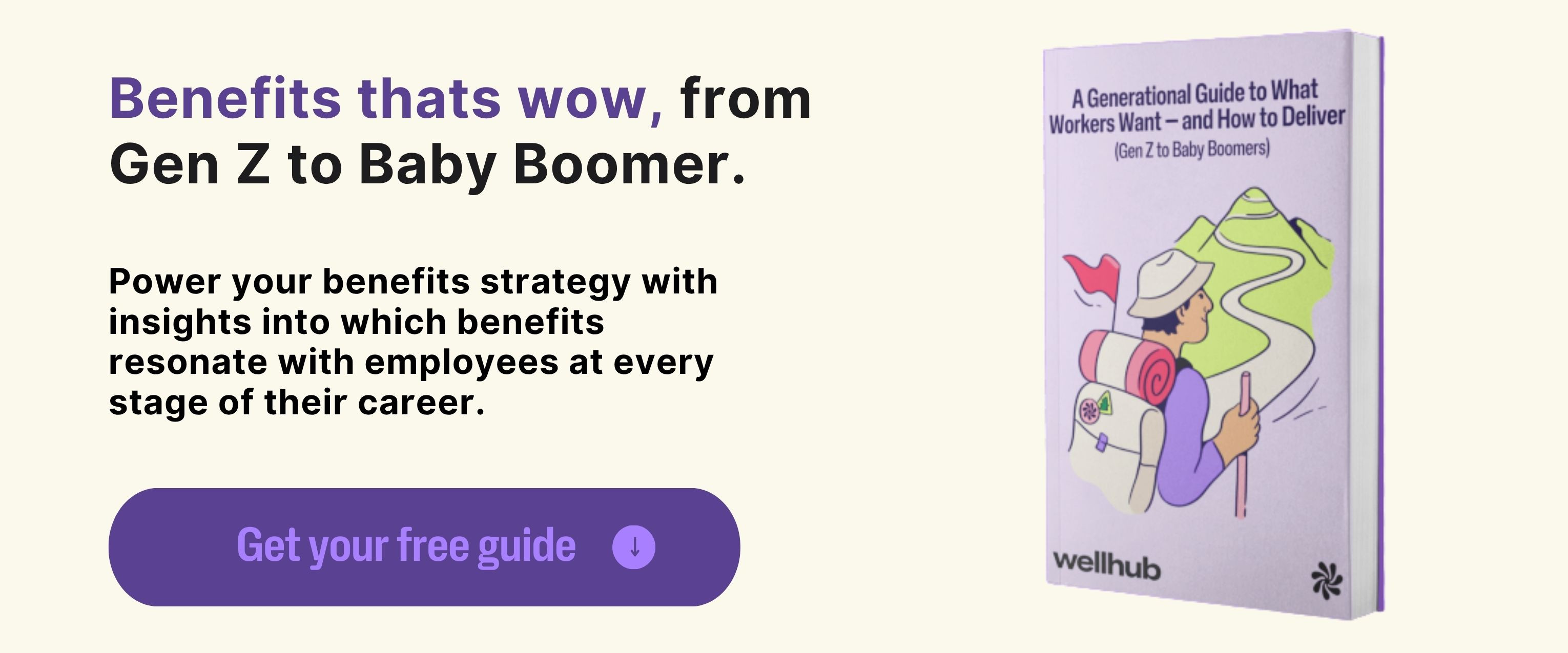
How can we include and engage our remote or distributed employees in wellness programs?
With many organizations going hybrid or fully remote, this is an important question. The last thing you want is your remote staff feeling like second-class citizens to on-site perks. The key is to make most wellness offerings location-agnostic or offer virtual equivalents. Some strategies:
- Virtual Wellness Classes: Any on-site fitness or yoga class can be streamed via Zoom for people at home. Alternatively, offer subscriptions to online fitness platforms (like Wellhub does, giving access to many digital fitness and mindfulness apps) so remote employees can work out on their own schedule.
- Wellness Kits by Mail: Send remote folks the tools to participate. For example, if you’re starting a step challenge and giving out pedometers or if you host a healthy cooking workshop, mail ingredients or a small kitchen gadget ahead of time. Even something simple like a branded water bottle or stress ball sent to their home can make them feel included.
- Leverage Digital Communities: Create a wellness channel on Slack/Teams where employees (office and remote alike) share their workout selfies, meditation streaks, or even pet photos for a mood boost. This can recreate the camaraderie of, say, a group walk – in a virtual space.
- Time Zone and Flexibility: If your remote team spans time zones, be mindful to rotate event times or record sessions. Maybe do a morning meditation that suits East Coast and a later one that suits Pacific, on different days. Ensure challenges can be done asynchronously (e.g. everyone aims for 8,000 steps a day, regardless of when/where).
- Local Alternatives: If you have clusters of remote workers in certain cities, consider regional meet-ups or partnerships. For example, offer a stipend or organized group for remote folks to join a local gym together or a community volunteer day in their city, wearing company T-shirts.
- Communication is Inclusive: Always announce wellness programs and successes in channels that reach remote employees equally. Share photos of in-office events on the intranet for all to see, and likewise highlight remote participants (“Shoutout to our Seattle team who all went on a hike together as part of Wellness Week!”). This mutual visibility prevents FOMO and builds unity.
It’s critical to check in with your remote employees about what wellness support they need. Some might struggle with setting boundaries when working from home (leading to overwork), so maybe a workshop on work-life wellness for remote work would help. Others might feel isolated, so increase the social connection aspect for them (virtual coffee roulettes, etc., as mentioned). Flexibility programs (like flexible hours, mental health days) benefit remote folks as much as office ones. In fact, remote workers often log longer hours; wellness initiatives can remind them to pause and take care of themselves too. By being intentional, you can make your wellness program a glue that holds the whole company together, no matter where people sit.
Launch a wellness program that lifts engagement and lowers costs.
How do we get leadership buy-in (and sustain it) for wellness initiatives?
Start by speaking the language of the C-suite: business outcomes. Tie wellness proposals to things leaders care about – productivity, cost savings, talent retention, employer brand. Use data from this article (and your own employee surveys) to paint the picture. For instance, you can point out that “79% of employees with wellness programs feel HR cares, versus 45% without, and we know feeling cared for links to engagement and retention. We could likely improve our retention (currently X%) by investing in wellbeing, which saves money on hiring.” Also mention the rising issues: “Burnout and mental health leaves are up – if we don’t act, it will cost us in absenteeism and turnover.”
Most executives will relate to the idea that healthy employees perform better – you might cite that CEOs themselves overwhelmingly believe wellness initiatives improve resilience and morale (e.g. 73% of CEOs say their wellness programs are extremely impactful in building employee resilience, and 52% invest in wellness to boost morale and engagement). Essentially, show that this is a competitive advantage: companies that prioritize wellness are seen as employers of choice (important in tight labor markets) and they get more out of their people in a sustainable way.
Next, propose a pilot program. Leaders may be more willing to green-light a small-scale trial. Pick one or two wellness activities, set goals, and measure results over 3–6 months. Perhaps “We’ll implement a stress-reduction and flexibility initiative in the IT department, and aim to reduce their burnout scores by 20% while improving output. If successful, we expand company-wide.” Once you have some home-grown success data, it’s easier to ask for more budget.
Also, emphasize employee demand and expectations. If your internal surveys or suggestion box frequently mention desire for wellness or better work-life balance, bring that to leadership. In today’s climate, many top candidates ask about company wellness and culture during interviews – share anecdotal evidence if you have it (“We lost a candidate to a competitor, and they cited that the competitor had a more people-centric culture”). Leaders hate losing good people.
Finally, get an executive sponsor if you can – someone at the leadership level who’s personally passionate about wellbeing (there’s usually at least one fitness enthusiast or mindful leader up there!). Have them champion the cause among their peers, share their own wellness story, or even allocate some of their budget to it. When leadership models wellness (like the CEO openly taking a mental health day or joining the lunchtime run club), it sets the tone for everyone. Sustaining buy-in comes from showing progress: regularly report back to leadership on positive trends – “Healthcare costs came in 5% lower than projected this year, partially thanks to our wellness program usage” or “Engagement scores in the pilot group jumped 10 points.” Over time, the conversation shifts from “Can we afford to do this?” to “We can’t afford not to.”
Wellness Activities Can Strengthen Culture, Performance, and Retention
Burnout, disengagement, and rising mental health concerns are taking a toll on employees—and on business outcomes. Many HR leaders face the challenge of supporting a workforce that’s struggling while trying to maintain performance, morale, and retention.
A well-rounded employee wellbeing program directly addresses these issues. It supports physical, mental, and social health while promoting flexibility and financial confidence. Companies that invest in these programs don’t just see happier teams—they see measurable results. For example, 75% of employees in companies with comprehensive wellness programs report improved mental wellbeing, compared to just 43% without.
Speak with a Wellhub Wellbeing Specialist to create a wellness program that helps your people thrive—and your company perform at its best.

Company healthcare costs drop by up to 35% with Wellhub*
See how we can help you reduce your healthcare spending.
Category
Share

The Wellhub Editorial Team empowers HR leaders to support worker wellbeing. Our original research, trend analyses, and helpful how-tos provide the tools they need to improve workforce wellness in today's fast-shifting professional landscape.
Subscribe
Our weekly newsletter is your source of education and inspiration to help you create a corporate wellness program that actually matters.
Subscribe
Our weekly newsletter is your source of education and inspiration to help you create a corporate wellness program that actually matters.
You May Also Like

Corporate Wellness Trends HR Must Know for 2026 | Wellhub
See the top 2026 wellness trends shaping performance, retention, and culture—plus how HR can build a unified, ROI-driven wellbeing strategy.

Wellness Points Programs: Boost Employee Health & Engagement | Wellhub
Turn your workplace wellness strategy around with a points program that rewards healthy behavior with perks, from extra time off to gift cards.

Employee Financial Wellness Programs: Ultimate HR Guide | Wellhub
Create an effective financial wellness program that supports your employees in their financial needs, boosting productivity and retention.